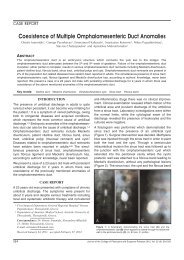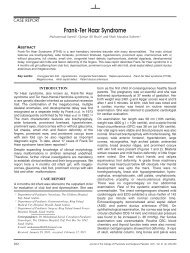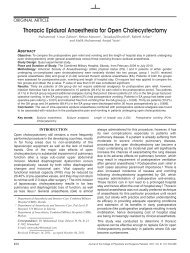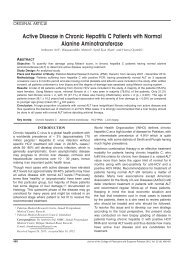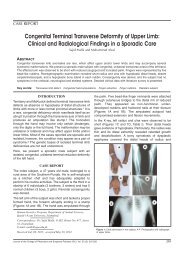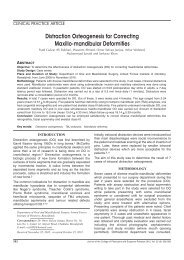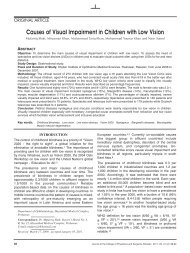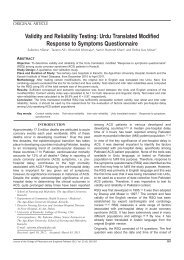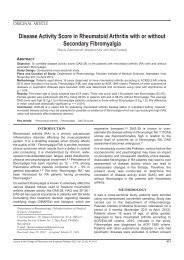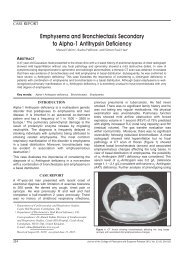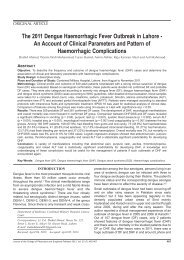Efficacy of L-ornithine-L-aspartate as an Adjuvant Therapy in ...
Efficacy of L-ornithine-L-aspartate as an Adjuvant Therapy in ...
Efficacy of L-ornithine-L-aspartate as an Adjuvant Therapy in ...
You also want an ePaper? Increase the reach of your titles
YUMPU automatically turns print PDFs into web optimized ePapers that Google loves.
ORIGINAL ARTICLE<br />
<strong>Efficacy</strong> <strong>of</strong> L-<strong>ornith<strong>in</strong>e</strong>-L-<strong><strong>as</strong>partate</strong> <strong>as</strong> <strong>an</strong> Adjuv<strong>an</strong>t <strong>Therapy</strong><br />
<strong>in</strong> Cirrhotic Patients with Hepatic Encephalopathy<br />
Shahab Abid, W<strong>as</strong>im Jafri, Khalid Mumtaz, Muhammad Islam*, Zaigham Abb<strong>as</strong>,<br />
H<strong>as</strong>na<strong>in</strong> Ali Shah <strong>an</strong>d Saeed Hamid<br />
ABSTRACT<br />
Objective: To evaluate the efficacy <strong>of</strong> L-<strong>ornith<strong>in</strong>e</strong>-L-<strong><strong>as</strong>partate</strong> (LOLA) <strong>as</strong> <strong>an</strong> adjuv<strong>an</strong>t therapy <strong>in</strong> cirrhotic patients with<br />
hepatic encephalopathy (HE).<br />
Study Design: R<strong>an</strong>domized placebo controlled study.<br />
Place <strong>an</strong>d Duration <strong>of</strong> Study: The Aga Kh<strong>an</strong> University Hospital, Karachi <strong>in</strong> the year 2003-2004.<br />
Methodology: Patients with HE were r<strong>an</strong>domized to receive LOLA or placebo medic<strong>in</strong>e <strong>as</strong> <strong>an</strong> adjuv<strong>an</strong>t to treatment <strong>of</strong><br />
HE. Number connection test-A (NCT-A), ammonia level, cl<strong>in</strong>ical grade <strong>of</strong> HE <strong>an</strong>d duration <strong>of</strong> hospitalization were<br />
<strong>as</strong>sessed.<br />
Results: Out <strong>of</strong> 120 patients, there were 62 males with me<strong>an</strong> age <strong>of</strong> 57 ± 11 years. Improvement <strong>in</strong> HE w<strong>as</strong> higher (n=40,<br />
66.7%) <strong>in</strong> LOLA group <strong>as</strong> compared to the placebo group (n=28, 46.7%, p=0.027). In patients with grade I or less<br />
encephalopathy, improvement w<strong>as</strong> seen <strong>in</strong> 6 (35.3%) <strong>an</strong>d 3 (20%) patients <strong>in</strong> LOLA <strong>an</strong>d placebo groups respectively<br />
(p=0.667). Patients with HE grade II <strong>an</strong>d above showed improvement <strong>in</strong> 34 (79.1%) <strong>an</strong>d 25 (55.6%) c<strong>as</strong>es <strong>in</strong> LOLA <strong>an</strong>d<br />
placebo group respectively (p=0.019). On multivariate <strong>an</strong>alysis patients with HE <strong>of</strong> grade II <strong>an</strong>d above showed prothromb<strong>in</strong><br />
time, creat<strong>in</strong><strong>in</strong>e level <strong>an</strong>d use <strong>of</strong> LOLA <strong>in</strong>fluenc<strong>in</strong>g the outcome. Duration <strong>of</strong> hospitalization w<strong>as</strong> 93.6±25.7 hours <strong>an</strong>d<br />
135.2±103.5 hours <strong>in</strong> LOLA <strong>an</strong>d placebo groups respectively (p=0.025). No side effects were observed <strong>in</strong> either groups.<br />
Conclusion: In cirrhotic patients with adv<strong>an</strong>ced hepatic encephalopathy treatment with LOLA w<strong>as</strong> safe <strong>an</strong>d <strong>as</strong>sociated<br />
with relatively rapid improvement <strong>an</strong>d shorter hospital stay.<br />
Key words:<br />
Hepatic encephalopathy. Liver cirrhosis. L-<strong>ornith<strong>in</strong>e</strong>-L-<strong><strong>as</strong>partate</strong>.<br />
INTRODUCTION<br />
Hepatic encephalopathy is characterized by the<br />
development <strong>of</strong> impaired central nervous system<br />
function that may r<strong>an</strong>ge from trivial abnormalities <strong>of</strong><br />
consciousness, personality, behaviour <strong>an</strong>d/or <strong>in</strong>tellectual<br />
function to deep coma. Hepatic encephalopathy may be<br />
cl<strong>in</strong>ically <strong>in</strong>visible, i.e. m<strong>in</strong>imal or sub-cl<strong>in</strong>ical, a syndrome<br />
that c<strong>an</strong> only be detected by the demonstration <strong>of</strong> subtle<br />
psychometric or electrophysiological abnormalities. 1,2<br />
The most common presentation is overt hepatic<br />
encephalopathy (HE), which occurs frequently <strong>in</strong><br />
patients with adv<strong>an</strong>ced cirrhosis with a well developed<br />
portal-systemic collateral circulation. 3,4<br />
HE is one <strong>of</strong> the major complications <strong>of</strong> cirrhosis. Five<br />
years after the diagnosis <strong>of</strong> cirrhosis, the probability <strong>of</strong><br />
develop<strong>in</strong>g at le<strong>as</strong>t one episode <strong>of</strong> this specific form <strong>of</strong><br />
decompensated cirrhosis is 26%. 5 The probability <strong>of</strong><br />
survival at 5 years is just 16-22%, once cl<strong>in</strong>ical<br />
decompensation h<strong>as</strong> occurred, compared with a survival<br />
Department <strong>of</strong> Medic<strong>in</strong>e / Community Health Science*, The Aga<br />
Kh<strong>an</strong> University Hospital, Karachi.<br />
Correspondence: Dr. Shahab Abid, Associate Pr<strong>of</strong>essor,<br />
Department <strong>of</strong> Medic<strong>in</strong>e, The Aga Kh<strong>an</strong> University Hospital,<br />
Stadium Road, Karachi.<br />
E-mail: shahab.abid@aku.edu<br />
Received J<strong>an</strong>uary 05, 2011; accepted September 23, 2011.<br />
probability <strong>of</strong> 55-70% <strong>in</strong> cirrhotic patients without HE. 5,6<br />
Therefore, prevention <strong>an</strong>d effective treatment <strong>of</strong> HE may<br />
have import<strong>an</strong>t prognostic implications <strong>in</strong> cirrhotic<br />
patients.<br />
A number <strong>of</strong> tox<strong>in</strong>s are implicated <strong>in</strong> the pathogenesis <strong>of</strong><br />
HE, with ammonia rema<strong>in</strong><strong>in</strong>g the ma<strong>in</strong> c<strong>an</strong>didate<br />
neurotox<strong>in</strong>. 7 The neurotox<strong>in</strong> ammonia plays a decisive<br />
role <strong>in</strong> the pathogenesis <strong>of</strong> HE by a variety <strong>of</strong> postulated<br />
mech<strong>an</strong>isms. 8<br />
Episodes <strong>of</strong> hepatic encephalopathy <strong>in</strong> patients with<br />
liver cirrhosis are usually <strong>in</strong>duced by precipitat<strong>in</strong>g<br />
factors like dehydration, constipation, g<strong>as</strong>tro<strong>in</strong>test<strong>in</strong>al<br />
bleed<strong>in</strong>g, <strong>in</strong>fections, hypokalemia, hypoxemia, the use<br />
<strong>of</strong> psychotropic drugs, or alcohol <strong>in</strong>take. 4 Precipitat<strong>in</strong>g<br />
factors seem to relev<strong>an</strong>tly <strong>in</strong>cre<strong>as</strong>e body ammonia<br />
levels <strong>an</strong>d their identification <strong>an</strong>d alleviation rema<strong>in</strong>s a<br />
keystone <strong>in</strong> the treatment <strong>of</strong> HE. In general, the majority<br />
<strong>of</strong> therapeutic me<strong>as</strong>ures are directed towards reduc<strong>in</strong>g<br />
blood ammonia levels, ma<strong>in</strong>ly by dim<strong>in</strong>ish<strong>in</strong>g the enteric<br />
ammonia production via treatment with lactulose <strong>an</strong>d<br />
metronidazole. 9 However, not all <strong>of</strong> these therapeutic<br />
options comply with the st<strong>an</strong>dards <strong>of</strong> evidence b<strong>as</strong>ed<br />
medic<strong>in</strong>e. 10<br />
L-<strong>ornith<strong>in</strong>e</strong>-L-<strong><strong>as</strong>partate</strong> (LOLA), the stable salt <strong>of</strong> the<br />
am<strong>in</strong>o acids <strong>ornith<strong>in</strong>e</strong> <strong>an</strong>d <strong>as</strong>partic acid, <strong>in</strong> several<br />
cl<strong>in</strong>ical trials h<strong>as</strong> shown to reduce blood ammonia levels<br />
<strong>an</strong>d improve psychometric perform<strong>an</strong>ce <strong>in</strong> patients with<br />
666 Journal <strong>of</strong> the College <strong>of</strong> Physici<strong>an</strong>s <strong>an</strong>d Surgeons Pakist<strong>an</strong> 2011, Vol. 21 (11): 666-671
L-<strong>ornith<strong>in</strong>e</strong>-L-<strong><strong>as</strong>partate</strong> <strong>in</strong> cirrhotic patients with hepatic encephalopathy<br />
HE. LOLA stimulates the urea cycle <strong>an</strong>d glutam<strong>in</strong>e<br />
synthesis, which are import<strong>an</strong>t mech<strong>an</strong>isms <strong>in</strong> ammonia<br />
detoxification. 11,12 Ammonia lower<strong>in</strong>g effect <strong>of</strong> LOLA is<br />
controversial. Some studies have demonstrated a<br />
decre<strong>as</strong>e <strong>in</strong> ammonia level <strong>in</strong> patients with HE who were<br />
treated by LOLA. 13,14 While, a recently published study<br />
<strong>in</strong> patients with acute liver failure did not show the<br />
ammonia lower<strong>in</strong>g effect <strong>of</strong> LOLA. 15<br />
Currently no large controlled cl<strong>in</strong>ical trial <strong>of</strong> specific<br />
treatment <strong>of</strong> proven efficacy is available for HE<br />
accord<strong>in</strong>g to the st<strong>an</strong>dards <strong>of</strong> evidence b<strong>as</strong>ed medic<strong>in</strong>e.<br />
Moreover, only patients with m<strong>in</strong>imal HE or grade 1 were<br />
enrolled <strong>in</strong> previous cl<strong>in</strong>ical trials <strong>of</strong> LOLA. 12,16<br />
Therefore, this study aimed to <strong>as</strong>sess the efficacy<br />
<strong>an</strong>d safety <strong>of</strong> L-<strong>ornith<strong>in</strong>e</strong> -L-<strong><strong>as</strong>partate</strong> <strong>as</strong> <strong>an</strong> adjuv<strong>an</strong>t<br />
therapy <strong>in</strong> cirrhotic patients with all grades <strong>of</strong> HE,<br />
start<strong>in</strong>g from m<strong>in</strong>imal hepatic encephalopathy to overt<br />
HE <strong>of</strong> grades 1-4.<br />
METHODOLOGY<br />
This w<strong>as</strong> a r<strong>an</strong>domized, double-bl<strong>in</strong>d, placebocontrolled,<br />
prospective study conducted at The Aga<br />
Kh<strong>an</strong> University Hospital, Karachi, dur<strong>in</strong>g 2003-04.<br />
The formal approval from the <strong>in</strong>stitutional ethical review<br />
committee (ERC) <strong>of</strong> the hospital w<strong>as</strong> gr<strong>an</strong>ted before<br />
start <strong>of</strong> the trial. The trial w<strong>as</strong> also registered through<br />
Cl<strong>in</strong>ic Trial. gov, Protocol Registration System (identification<br />
number NCT00433368).<br />
A written <strong>in</strong>formed consent w<strong>as</strong> taken from the patient or<br />
attend<strong>an</strong>t (<strong>in</strong> c<strong>as</strong>es where patients were unable to<br />
underst<strong>an</strong>d <strong>an</strong>d sign consent due to adv<strong>an</strong>ced HE)<br />
before enrolment to the study.<br />
Patients who met the follow<strong>in</strong>g <strong>in</strong>clusion criteria were<br />
eligible for the study: 1) cirrhosis, diagnosed on the<br />
b<strong>as</strong>is <strong>of</strong> cl<strong>in</strong>ical f<strong>in</strong>d<strong>in</strong>gs, ultr<strong>as</strong>onic <strong>an</strong>d/or histologic<br />
b<strong>as</strong>is; (2) patients age more th<strong>an</strong> 18 years, with HE<br />
grades 1-4 accord<strong>in</strong>g to West Haven criteria; 3) patients<br />
were grouped <strong>as</strong> m<strong>in</strong>imal HE if NCT-A completion<br />
took more th<strong>an</strong> 30 seconds <strong>an</strong>d no other sign <strong>of</strong><br />
encephalopathy present; 17-19 (4) hyperammonemia<br />
(f<strong>as</strong>t<strong>in</strong>g venous blood ammonia level greater th<strong>an</strong><br />
60 µmol/l); <strong>an</strong>d (5) patients with or without a s<strong>in</strong>gle<br />
reversible precipitat<strong>in</strong>g factor <strong>of</strong> HE such <strong>as</strong> constipation,<br />
hypokalemia, ur<strong>in</strong>ary tract <strong>in</strong>fection, respiratory<br />
tract <strong>in</strong>fection, spont<strong>an</strong>eous bacterial peritonitis (SBP),<br />
or dehydration.<br />
A diagnostic paracentesis w<strong>as</strong> performed <strong>in</strong> all patients<br />
with <strong>as</strong>cites to diagnose SBP. Similarly, ur<strong>in</strong>e culture <strong>an</strong>d<br />
chest X-ray were done <strong>in</strong> all patients to diagnose ur<strong>in</strong>ary<br />
tract <strong>in</strong>fection (UTI) <strong>an</strong>d respiratory tract <strong>in</strong>fection (RTI)<br />
respectively. Hypokalemia w<strong>as</strong> labeled when serum<br />
pot<strong>as</strong>sium level on admission w<strong>as</strong> < 3.5 meq / liter. SBP<br />
<strong>an</strong>d other <strong>in</strong>fections were treated with appropriate<br />
<strong>in</strong>travenous <strong>an</strong>tibiotics for 3 days followed by oral form if<br />
HE improved.<br />
Exclusion criteria were hepatocellular carc<strong>in</strong>oma,<br />
severe septicemia with compromised hemodynamic<br />
status, active g<strong>as</strong>tro<strong>in</strong>test<strong>in</strong>al bleed<strong>in</strong>g, hepatorenal<br />
syndrome, acute superimposed liver <strong>in</strong>jury, adv<strong>an</strong>ced<br />
cardiac or pulmonary dise<strong>as</strong>e <strong>an</strong>d end stage renal<br />
failure. Patients tak<strong>in</strong>g sedatives, <strong>an</strong>tidepress<strong>an</strong>ts, or<br />
benzodiazep<strong>in</strong>es <strong>an</strong>d patients with chronic HE on<br />
metronidazole or lactulose prior to admission were also<br />
not <strong>in</strong>cluded.<br />
Patients admitted to the hospital via outpatient cl<strong>in</strong>ic or<br />
emergency room were <strong>as</strong>sessed at r<strong>an</strong>domization<br />
(Day 0, before start <strong>of</strong> treatment). The r<strong>an</strong>domization<br />
w<strong>as</strong> performed with<strong>in</strong> 12 hours <strong>of</strong> admission <strong>in</strong> the<br />
hospital. Patients were r<strong>an</strong>domly allocated to two<br />
treatment groups, i.e. L-<strong>ornith<strong>in</strong>e</strong>-L-<strong><strong>as</strong>partate</strong> (LOLA) or<br />
placebo, us<strong>in</strong>g sequentially numbered, sealed, opaque<br />
envelopes. Both groups were given lactulose <strong>an</strong>d<br />
metronidazole <strong>as</strong> per rout<strong>in</strong>e m<strong>an</strong>agement <strong>of</strong> hepatic<br />
encephalopahty.<br />
Intravenous <strong>in</strong>fusions were adm<strong>in</strong>istered daily over<br />
4 hours from 08:00 to 12:00 a.m for 3 consecutive days<br />
<strong>an</strong>d conta<strong>in</strong>ed either 20 g LOLA (4 ampoules <strong>of</strong> 10 ml<br />
each) or placebo (4 ampoules <strong>of</strong> 10 ml distilled water<br />
each) both mixed <strong>in</strong> 250 ml 5% dextrose. The active<br />
agent <strong>an</strong>d placebo were <strong>in</strong>dist<strong>in</strong>guishable <strong>in</strong> colour <strong>an</strong>d<br />
appear<strong>an</strong>ce.<br />
Concomit<strong>an</strong>t medications were required for the<br />
treatment <strong>of</strong> precipitat<strong>in</strong>g factor, such <strong>as</strong> <strong>an</strong>tibiotics for<br />
<strong>in</strong>fection, pot<strong>as</strong>sium replacement for hypokalemia, <strong>an</strong>d<br />
<strong>in</strong>travenous dextrose sal<strong>in</strong>e for dehydration. Diuretics<br />
<strong>an</strong>d beta-adrenergic block<strong>in</strong>g drugs were stopped <strong>an</strong>d a<br />
salt restricted diet w<strong>as</strong> started <strong>in</strong> both treatment groups.<br />
Improvement/deterioration <strong>in</strong> HE grade (b<strong>as</strong>ed on NCT-<br />
A <strong>an</strong>d West Haven criteria) w<strong>as</strong> def<strong>in</strong>ed <strong>as</strong> the primary<br />
outcome variable. Improvement <strong>in</strong> length <strong>of</strong> hospital<br />
stay, improvement <strong>in</strong> f<strong>as</strong>t<strong>in</strong>g ammonia level, <strong>an</strong>d<br />
mortality rate were recorded <strong>as</strong> secondary outcome<br />
variables. The mental state w<strong>as</strong> graded on a 0-4 scale<br />
accord<strong>in</strong>g to the West Haven criteria. 17,18 Number<br />
connection test (NCT-A) w<strong>as</strong> performed <strong>in</strong> patients with<br />
m<strong>in</strong>imal hepatic encephalopathy (MHE) <strong>an</strong>d grade-I<br />
HE. 21 NCT time w<strong>as</strong> checked daily with the help <strong>of</strong> four<br />
parallel variations <strong>of</strong> NCT test, validated to be <strong>of</strong> equal<br />
difficulty, <strong>as</strong> demonstrated <strong>in</strong> literature. 4 In patients with<br />
m<strong>in</strong>imal <strong>an</strong>d grade-I HE, “def<strong>in</strong>ite improvement” w<strong>as</strong><br />
achievement <strong>of</strong> HE- 0 at end <strong>of</strong> treatment accord<strong>in</strong>g to<br />
West Haven criteria. In patients with HE grade ≥ II, HE<br />
w<strong>as</strong> “def<strong>in</strong>itely improved” whenever it improves to two<br />
grades from b<strong>as</strong>el<strong>in</strong>e; <strong>an</strong>d rated <strong>as</strong> “partially improved”<br />
when a decre<strong>as</strong>e <strong>of</strong> 1 grade accord<strong>in</strong>g to West<br />
Haven criteria w<strong>as</strong> observed between b<strong>as</strong>el<strong>in</strong>e <strong>an</strong>d<br />
Day 3, but not reach<strong>in</strong>g to grade 0; “no improvement/<br />
deterioration”, when HE h<strong>as</strong> not improved or<br />
deteriorated. Physici<strong>an</strong>s were tra<strong>in</strong>ed for correct <strong>an</strong>d<br />
consistent use <strong>of</strong> mental state grad<strong>in</strong>g <strong>an</strong>d NCT-A prior<br />
to start <strong>of</strong> study.<br />
Journal <strong>of</strong> the College <strong>of</strong> Physici<strong>an</strong>s <strong>an</strong>d Surgeons Pakist<strong>an</strong> 2011, Vol. 21 (11): 666-671 667
Shahab Abid, W<strong>as</strong>im Jafri, Khalid Mumtaz, Muhammad Islam, Zaigham Abb<strong>as</strong>, H<strong>as</strong>na<strong>in</strong> Ali Shah <strong>an</strong>d Saeed Hamid<br />
Samples for ammonia were drawn <strong>in</strong>to hepar<strong>in</strong>ized<br />
vacuta<strong>in</strong>er tubes (Becton, Dick<strong>in</strong>son <strong>an</strong>d Comp<strong>an</strong>y,<br />
Fr<strong>an</strong>kl<strong>in</strong> Lakes, New Jersey), <strong>an</strong>d <strong>an</strong>alyzed with<strong>in</strong><br />
30 m<strong>in</strong>utes. Initial venous ammonia levels were checked<br />
<strong>in</strong> all the patients on day 0 at the time <strong>of</strong> admission.<br />
Thereafter, the postpr<strong>an</strong>dial venous ammonia levels<br />
were checked from day 1 to day 3 <strong>of</strong> treatment <strong>in</strong> both<br />
the groups after 4 hours <strong>of</strong> <strong>in</strong>fusion <strong>of</strong> LOLA or placebo.<br />
Hospital stay w<strong>as</strong> monitored (<strong>in</strong> hours) <strong>of</strong> patients <strong>an</strong>d<br />
<strong>in</strong>-hospital mortality <strong>in</strong> the LOLA <strong>an</strong>d placebo groups <strong>of</strong><br />
treatment. Laboratory parameters were determ<strong>in</strong>ed on<br />
Days 0 <strong>an</strong>d 3 <strong>an</strong>d <strong>in</strong>cluded haematology (haemoglob<strong>in</strong>,<br />
haematocrit, white blood cell count, platelets) <strong>an</strong>d liver<br />
function tests (al<strong>an</strong><strong>in</strong>e am<strong>in</strong>otr<strong>an</strong>sfer<strong>as</strong>e, gamma<br />
glutamyl tr<strong>an</strong>sfer<strong>as</strong>e serum bilirub<strong>in</strong>, serum album<strong>in</strong> <strong>an</strong>d<br />
prothromb<strong>in</strong> time).<br />
Patients who received at le<strong>as</strong>t 95% <strong>of</strong> study medication<br />
were considered compli<strong>an</strong>t. All adverse events were<br />
<strong>as</strong>sessed by the <strong>in</strong>vestigator accord<strong>in</strong>g to usual cl<strong>in</strong>ical<br />
evaluations. Any cl<strong>in</strong>ical or laboratory f<strong>in</strong>d<strong>in</strong>gs observed<br />
dur<strong>in</strong>g trial were monitored <strong>an</strong>d recorded until their<br />
normalization w<strong>as</strong> observed or their correlation with<br />
<strong>in</strong>vestigational medication could be expla<strong>in</strong>ed.<br />
A sample size <strong>of</strong> 55 patients from the LOLA group <strong>an</strong>d<br />
55 patients from the placebo group achieve 80% power<br />
at a 5% signific<strong>an</strong>ce level us<strong>in</strong>g equivalence test <strong>of</strong><br />
proportions by <strong>as</strong>sum<strong>in</strong>g 20% higher improvement <strong>in</strong><br />
LOLA <strong>as</strong> compared to placebo group. While improvement<br />
<strong>in</strong> placebo group w<strong>as</strong> used <strong>as</strong> 40% <strong>an</strong>d the<br />
maximum allowable difference between the group<br />
proportions that still results <strong>in</strong> equivalence (the r<strong>an</strong>ge <strong>of</strong><br />
equivalence) is 5%.<br />
All <strong>an</strong>alyses were carried out by us<strong>in</strong>g the Statistical<br />
Package for Social Sciences (SPSS) 19. Descriptive<br />
<strong>an</strong>alysis w<strong>as</strong> applied to demographic data <strong>an</strong>d b<strong>as</strong>el<strong>in</strong>e<br />
characteristics. Qu<strong>an</strong>titative variables were summarized<br />
by present<strong>in</strong>g me<strong>an</strong>s ± st<strong>an</strong>dard deviation with<br />
normally distributed data, however, medi<strong>an</strong> with r<strong>an</strong>ge<br />
were presented for skewed data. Frequencies <strong>an</strong>d<br />
percentages were given for qualitative variables.<br />
Between groups, me<strong>an</strong> differences <strong>in</strong> qu<strong>an</strong>titative<br />
outcome parameters were <strong>as</strong>sessed us<strong>in</strong>g <strong>in</strong>dependent<br />
t-tests or M<strong>an</strong>n Whitney U-test. Proportions were<br />
compared by Pearson's chi-square, where appropriate.<br />
Paired sample t-tests were used to <strong>an</strong>alyze the with<strong>in</strong>group<br />
ch<strong>an</strong>ges <strong>in</strong> ammonia concentration <strong>an</strong>d NCT-A<br />
from b<strong>as</strong>el<strong>in</strong>e to the end <strong>of</strong> treatment.<br />
Multiple logistic regression <strong>an</strong>alysis w<strong>as</strong> used to <strong>as</strong>sess<br />
the factor <strong>as</strong>sociated with improvement. All those<br />
variables which were signific<strong>an</strong>t at 20-25% level <strong>of</strong><br />
signific<strong>an</strong>ce were considered for multivariate <strong>an</strong>alysis.<br />
P-values < 0.05 were considered to be statistically<br />
signific<strong>an</strong>t. For <strong>as</strong>sessment <strong>of</strong> primary outcome we<br />
<strong>an</strong>alyzed MHE <strong>an</strong>d grade-I HE separately from grade-II<br />
<strong>an</strong>d above HE.<br />
RESULTS<br />
Out <strong>of</strong> 307 consecutive patients, a total <strong>of</strong> 120 patients<br />
with liver cirrhosis <strong>an</strong>d portal hypertension fulfilled the<br />
criteria <strong>of</strong> <strong>in</strong>clusion <strong>in</strong>to this cl<strong>in</strong>ical <strong>in</strong>vestigation. The<br />
data presented are b<strong>as</strong>ed on total study sample (<strong>in</strong>tentto-treat<br />
<strong>an</strong>alysis), which <strong>in</strong>cluded 60 patients <strong>in</strong> each<br />
group. The two r<strong>an</strong>dom groups were matched <strong>in</strong> age<br />
{me<strong>an</strong> age 57±11 years; 62 males (52%)}, etiology <strong>of</strong><br />
cirrhosis, Child-Turcotte-Pugh (CTP) cl<strong>as</strong>s, laboratory<br />
parameters (haemoglob<strong>in</strong>, urea, creat<strong>in</strong><strong>in</strong>e, electrolytes),<br />
grades <strong>of</strong> HE <strong>an</strong>d precipitat<strong>in</strong>g factors (Table I).<br />
B<strong>as</strong>el<strong>in</strong>e severity <strong>of</strong> hepatic encephalopathy <strong>an</strong>d<br />
improvement after LOLA or placebo adm<strong>in</strong>istration<br />
Table II. NCT-A score among LOLA patients w<strong>as</strong> 122<br />
+ 13 seconds at b<strong>as</strong>el<strong>in</strong>e that h<strong>as</strong> improved to 71 + 25<br />
seconds (p < 0.001) while <strong>in</strong> placebo group NCT-A w<strong>as</strong><br />
122 + 7 improved to 78 + 22 seconds), (p < 0.001);<br />
however, 3 patients <strong>in</strong> placebo group deteriorated <strong>an</strong>d<br />
hence, NCT w<strong>as</strong> not calculated. A comparison <strong>in</strong> NCT<br />
w<strong>as</strong> not done between LOLA <strong>an</strong>d control groups <strong>as</strong><br />
3 patients who deteriorated from control group were<br />
unable to perform NCT.<br />
Table I:<br />
Patients characteristics <strong>of</strong> L-<strong>ornith<strong>in</strong>e</strong>-L-<strong><strong>as</strong>partate</strong> (LOLA) <strong>an</strong>d<br />
placebo group.<br />
Characteristics LOLA Placebo<br />
n=60 n=60<br />
Age (years, me<strong>an</strong> ± SD) 57.1 ± 11.5 57.5 ± 11<br />
Gender, n (%)<br />
Male 30 (50) 32 (53.3)<br />
Female 30 (50) 28 (46.7)<br />
Etiology <strong>of</strong> cirrhosis, n (%)<br />
Hepatitis C 41 (68.3) 40 (66.7)<br />
Hepatitis B 05 (8.3) 06 (10.0)<br />
Non-B/non-C hepatitis 13 (21.7) 10 (16.7)<br />
Ethnol 01 (1.7) 04 (6.6)<br />
Child Pugh grade, n (%)<br />
B 13 (21.7) 08 (13.3)<br />
C 47 (78.3) 52 (86.7)<br />
Laboratory data*<br />
Hemoglob<strong>in</strong> (g/L) 10.4 (5.9 to 15.5) 10.7 (6.3 to 16.1)<br />
Leukocytes (x10E9/L) 9.3 (2.9 to 38.3) 8.5 (2.7 to 27)<br />
Platelets (x10E9/L) 105 (7.9 to 342) 112 (5 to 279)<br />
Total bilirub<strong>in</strong> (mg/dl) 2.9 (0.9 to 40) 4.3 (0.9 to 62)<br />
ALT (IU) 34 (14 to 1048) 45.5 (17 to 703)<br />
Alk. Phosphat<strong>as</strong>e (IU) 111 (42 to 430) 134 (53 to 330)<br />
PT (control 12) 19.9 (13 to 44) 19.5 (12.6 to 58)<br />
Album<strong>in</strong> (g/dl) 2.1 (1.2 to 3.9) 2 (1.3 to 3.8)<br />
Pot<strong>as</strong>sium (mEq/l) 4.1 (2.2 to 6.3) 4.1 (2.4 to 6.8)<br />
Creat<strong>in</strong><strong>in</strong>e (mg/dl) 1.2 (0.5 to 3.3) 1.3 (0.5 to 3.2)<br />
Ammonia level (µmol/l) 135.5 (33 to 497) 127.5 (53 to 304)<br />
Precipitat<strong>in</strong>g factors, n (%)<br />
Constipation 13 (21.7) 18 (30.0)<br />
Hypokalemia 06 (10.0) 04 (6.7)<br />
Ur<strong>in</strong>ary tract <strong>in</strong>fection 11 (18.3) 05 (8.3)<br />
Respiratory tract <strong>in</strong>fection 02 (3.3) –<br />
SBP 14 (23.3) 17 (28.3)<br />
None 16 (26.7) 19 (31.7)<br />
SD=St<strong>an</strong>dard deviation, * result presented <strong>as</strong> medi<strong>an</strong> (r<strong>an</strong>ge).<br />
668 Journal <strong>of</strong> the College <strong>of</strong> Physici<strong>an</strong>s <strong>an</strong>d Surgeons Pakist<strong>an</strong> 2011, Vol. 21 (11): 666-671
L-<strong>ornith<strong>in</strong>e</strong>-L-<strong><strong>as</strong>partate</strong> <strong>in</strong> cirrhotic patients with hepatic encephalopathy<br />
Table II: Hepatic encephalopathy grade wise improvement <strong>in</strong> the two treatment groups.<br />
L-Ornith<strong>in</strong>e L-<strong><strong>as</strong>partate</strong> (LOLA) (n=60)<br />
Placebo (n=60)<br />
Grade <strong>of</strong> HE* Complete Partial No improvement/ Complete improvement Partial improvement No improvement/<br />
improvement improvement deterioration deterioration<br />
MHE 6/6 (100) - - 3/6 (50) - 3/6 (50)<br />
Grade I 11/11 (100) - - - 9/9 (100) -<br />
Grade II** 14/18 (78) 2/18 (11) 2/18 (11) 10/18 (55) 5/18 (28) 3/18 (17)<br />
Grade III** 15/18 (83) 1/18 (6) 2/18 (11) 11/19 (58) 2/19 (10) 6/19 (32)<br />
Grade IV** 5/7 (72) 1/7 (14) 1/7 (14) 4/8 (40) 3/8 (38) 1/8 (12)<br />
* Analyzed comb<strong>in</strong>ed all grade showed signific<strong>an</strong>t improvement <strong>in</strong> LOLA group compared to placebo (p = < 0.001).<br />
** Analyzed together showed better improvement <strong>in</strong> LOLA group compared to placebo (p=0.019).<br />
Table III: Factor <strong>as</strong>sociated with def<strong>in</strong>ite improvement for grade II <strong>an</strong>d<br />
above <strong>in</strong> univariate <strong>an</strong>alysis.<br />
Factors Partial No-completer p-value<br />
improvement improvement<br />
n=29 (%) n=59 (%)<br />
Age (years, me<strong>an</strong> ± SD) 57.5 ± 11 57.1 ± 11.5 0.893†<br />
Treatment group<br />
Placebo 20 (44.4) 25 (55.6) 0.019‡<br />
LOLA 9 (20.9) 34 (79.1)<br />
Laboratory data*<br />
Hemoglob<strong>in</strong> (g/L) 9.1 (6.6 to 15) 11.1 (5.9 to 16.1) 0.014§<br />
Leukocytes (x10E9/L) 9.0 (2.7 to 27) 9.3 (2.9 to 38.3) 0.648§<br />
Platelets (x10E9/L) 122 (32 to 292) 112 (5.9 to 342) 0.445§<br />
Total bilirub<strong>in</strong> (mg/dl) 4.9 (1.2 to 40) 2.7 (0.9 to 62) 0.053§<br />
ALT (IU) 48.5 (17 to 481) 46.5 (15 to 1048) 0.657§<br />
Alk. Phosphat<strong>as</strong>e (IU) 137.5 (42 to 430) 127 (48 to 330) 0.969§<br />
PT (control 12) 24.1 (12.6 to 44) 18.2 (12.8 to 58) 0.016§<br />
Album<strong>in</strong> (g/dl) 1.7 (1.3 to 3.9) 2.2 (1.3 to 3.9) 0.018§<br />
Pot<strong>as</strong>sium (mEq/l) 3.7 (2.7 to 5.8) 4.1 (2.4 to 6.8) 0.261†<br />
Creat<strong>in</strong><strong>in</strong>e (mg/dl) 1.5 (0.6 to 3.3) 1.3 (0.5 to 3.1) 0.089§<br />
Ammonia level (µmol/l) 130 (52 to 497) 134 (33 to 345) 0.327†<br />
SD=St<strong>an</strong>dard deviation; * result presented <strong>as</strong> medi<strong>an</strong> (r<strong>an</strong>ge); † p-value calculated b<strong>as</strong>ed<br />
on t-test; ‡ b<strong>as</strong>ed on Pearson chi-square; § calculated b<strong>as</strong>ed on M<strong>an</strong>n Whitney U test.<br />
Table IV: Independent factor <strong>as</strong>sociated with def<strong>in</strong>ite improvement for<br />
grade II <strong>an</strong>d above <strong>in</strong> logistic regression.<br />
Variables Adjusted 95% C.I for p-value<br />
odds ratio adjusted odds ratio<br />
Treatment groups<br />
Placebo 1<br />
LOLA 3.9 (1.30, 11.74) 0.015<br />
Creat<strong>in</strong><strong>in</strong>e 0.35 (0.15, 0.83) 0.017<br />
PT 0.95 (0.89, 1.00) 0.064<br />
Reference category.<br />
Table V: Blood ammonia levels <strong>in</strong> L-<strong>ornith<strong>in</strong>e</strong> L-<strong><strong>as</strong>partate</strong> <strong>an</strong>d placebo<br />
groups.<br />
Grade <strong>of</strong> HE L-<strong>ornith<strong>in</strong>e</strong>-L-<strong><strong>as</strong>partate</strong> Placebo<br />
Day 0 Day 3 Day 0 Day 3<br />
n n n n<br />
(me<strong>an</strong> + SD) (me<strong>an</strong> + SD) (me<strong>an</strong> + SD) (me<strong>an</strong> + SD)<br />
17 17 15 15<br />
M<strong>in</strong>imal HE/grade 1 (126 + 42) (105 + 19) (140 + 44) (143 + 57)<br />
18 18 18 18<br />
HE grade 2 (129 + 51) (116 + 51) (151 + 79) (131 + 42)<br />
18 18 19 19<br />
HE grade 3 (148 + 70) (134 + 56) (150 + 60) (152 + 99)<br />
7 7 8 8<br />
HE grade 4 (151 + 59) (109 + 25) (185 + 36) (153 + 81)<br />
Me<strong>an</strong> ch<strong>an</strong>ge with (95% C.I.) <strong>in</strong> LOLA group 18.8 (5.3, 32.3) p=0.007, <strong>in</strong> placebo group 8.7<br />
(-13.3, 30.8) p=0.431.<br />
Overall def<strong>in</strong>ite improvement <strong>in</strong> LOLA group w<strong>as</strong> higher<br />
40/60 (66.7%) <strong>as</strong> compared to placebo group 28/60<br />
(46.7%), p < 0.001; moreover, 17/17 (100%) patients<br />
who received LOLA with grade-I or MHE improved<br />
while <strong>in</strong> placebo group 3/15 (20%) showed def<strong>in</strong>ite<br />
improvement (p < 0.001).<br />
Patients with HE grade II <strong>an</strong>d above who received LOLA<br />
34/43 (79%) improved compared to 25/45 (55.6%) <strong>in</strong><br />
placebo group (p=0.019). Overall factors were not found<br />
signific<strong>an</strong>t when the whole group w<strong>as</strong> evaluated.<br />
On subset <strong>an</strong>alysis only patients with HE <strong>of</strong> grade-II <strong>an</strong>d<br />
above showed that prothromb<strong>in</strong> time, creat<strong>in</strong><strong>in</strong>e level<br />
<strong>an</strong>d use <strong>of</strong> LOLA <strong>in</strong>fluenc<strong>in</strong>g the outcome <strong>of</strong> HE (Tables<br />
III <strong>an</strong>d IV). There w<strong>as</strong> a signific<strong>an</strong>t decl<strong>in</strong>e <strong>in</strong> ammonia<br />
levels <strong>in</strong> LOLA group; the me<strong>an</strong> difference <strong>an</strong>d CI<br />
between day 0 <strong>an</strong>d day 3 <strong>in</strong> ammonia level w<strong>as</strong> 18.8<br />
(5.3, 32.3) p=0.01. The ch<strong>an</strong>ge <strong>in</strong> ammonia level w<strong>as</strong>,<br />
however, not signific<strong>an</strong>t <strong>in</strong> the placebo group even after<br />
exclud<strong>in</strong>g those patients who deteriorated from MHE to<br />
higher grades; 13.3 (-8.3, 34.9) p=0.182 (Table V). The<br />
medi<strong>an</strong> duration <strong>of</strong> hospitalization w<strong>as</strong> signific<strong>an</strong>tly<br />
shorter follow<strong>in</strong>g treatment with LOLA compared to<br />
placebo; 96 hours (r<strong>an</strong>ge 48-574) <strong>an</strong>d 96 hours<br />
(r<strong>an</strong>ge 90-240) respectively (p=0.025). Overall, 4/60<br />
patients (7%) receiv<strong>in</strong>g LOLA <strong>in</strong>fusions died dur<strong>in</strong>g <strong>in</strong>patient<br />
care <strong>as</strong> compared to 7/60 (12%) patients treated<br />
with match<strong>in</strong>g placebo group (p=0.343).<br />
A compli<strong>an</strong>ce <strong>of</strong> 100% w<strong>as</strong> achieved for both the active<br />
medication <strong>an</strong>d treatment with placebo <strong>in</strong> this cl<strong>in</strong>ical<br />
trial. No adverse drug reactions <strong>in</strong> terms <strong>of</strong> symptoms<br />
or biochemical laboratory deviations were observed <strong>in</strong><br />
either group.<br />
DISCUSSION<br />
The present study aimed at explor<strong>in</strong>g the efficacy <strong>of</strong><br />
<strong>in</strong>travenously adm<strong>in</strong>istered LOLA <strong>in</strong> a r<strong>an</strong>domized,<br />
placebo controlled, double bl<strong>in</strong>d trial <strong>in</strong> a def<strong>in</strong>ed<br />
population <strong>of</strong> cirrhotic patients with encephalopathy. In<br />
this trial all grades <strong>of</strong> encephalopathy were <strong>in</strong>cluded<br />
r<strong>an</strong>g<strong>in</strong>g from m<strong>in</strong>imal to overt hepatic encephalopathy.<br />
L-<strong>ornith<strong>in</strong>e</strong> L-<strong><strong>as</strong>partate</strong> w<strong>as</strong> found safe <strong>as</strong> <strong>an</strong> adjuv<strong>an</strong>t<br />
therapy <strong>in</strong> the m<strong>an</strong>agement <strong>of</strong> HE along with st<strong>an</strong>dard<br />
m<strong>an</strong>agement. Moreover, LOLA showed signific<strong>an</strong>t<br />
improvement <strong>in</strong> patients with grade-I or m<strong>in</strong>imal HE<br />
Journal <strong>of</strong> the College <strong>of</strong> Physici<strong>an</strong>s <strong>an</strong>d Surgeons Pakist<strong>an</strong> 2011, Vol. 21 (11): 666-671 669
Shahab Abid, W<strong>as</strong>im Jafri, Khalid Mumtaz, Muhammad Islam, Zaigham Abb<strong>as</strong>, H<strong>as</strong>na<strong>in</strong> Ali Shah <strong>an</strong>d Saeed Hamid<br />
compared to placebo. This apparent beneficial effect <strong>of</strong><br />
LOLA could be due to the fact that 3 patients <strong>in</strong> the<br />
placebo group actually deteriorated. Whether LOLA<br />
prevented a similar deterioration <strong>of</strong> HE <strong>in</strong> the active<br />
treatment arm c<strong>an</strong>not be determ<strong>in</strong>ed from this study.<br />
Another <strong>in</strong>terest<strong>in</strong>g f<strong>in</strong>d<strong>in</strong>g is better outcome <strong>of</strong> patients<br />
with adv<strong>an</strong>ced grades <strong>of</strong> encephalopathy <strong>in</strong> LOLA group<br />
compared to placebo, which w<strong>as</strong> statistically signific<strong>an</strong>t.<br />
This study is the first r<strong>an</strong>domized, placebo-controlled<br />
<strong>in</strong>vestigation that h<strong>as</strong> <strong>in</strong>cluded patients with all stages <strong>of</strong><br />
HE. Moreover, unlike previous studies patients with a<br />
variety <strong>of</strong> precipitat<strong>in</strong>g factors were <strong>in</strong>cluded that were<br />
equally distributed <strong>in</strong> the two treatment groups.<br />
Therefore, the selection <strong>of</strong> study subjects <strong>in</strong> the present<br />
study w<strong>as</strong> closer to the real-time cl<strong>in</strong>ical situation where<br />
patients with or without precipitat<strong>in</strong>g factors <strong>an</strong>d various<br />
grades were subjected to r<strong>an</strong>domized treatment. This<br />
h<strong>as</strong> also reduces the element <strong>of</strong> selection bi<strong>as</strong> <strong>in</strong> this<br />
study. Previously reported controlled studies <strong>of</strong> LOLA<br />
were performed <strong>in</strong> patients with HE <strong>of</strong> milder severity<br />
(grades I <strong>an</strong>d II), 11,12,16,17 <strong>an</strong>d did not <strong>in</strong>clude the<br />
patients with precipitat<strong>in</strong>g factors.<br />
A signific<strong>an</strong>t drop <strong>in</strong> f<strong>as</strong>t<strong>in</strong>g ammonia concentrations<br />
w<strong>as</strong> observed <strong>in</strong> patients given LOLA, compared to<br />
their b<strong>as</strong>el<strong>in</strong>e values this effect w<strong>as</strong> not evident <strong>in</strong> the<br />
placebo group, similar results were found <strong>in</strong> the other<br />
studies elsewhere. 4,20,21 A recently conducted double<br />
bl<strong>in</strong>d study from Austria h<strong>as</strong> demonstrated <strong>an</strong> improvement<br />
<strong>in</strong> posturographic control <strong>in</strong> patients with HE. 22<br />
This study also suggested a possible augmentation <strong>in</strong><br />
the improvement <strong>of</strong> cl<strong>in</strong>ical condition <strong>of</strong> patients with HE<br />
by us<strong>in</strong>g LOLA <strong>in</strong> addition to <strong>in</strong>travenous fluids.<br />
A signific<strong>an</strong>t decre<strong>as</strong>e <strong>in</strong> the length <strong>of</strong> hospital stay w<strong>as</strong><br />
observed <strong>in</strong> patients who received LOLA compared to<br />
those who were on placebo <strong>as</strong> <strong>an</strong> adjuv<strong>an</strong>t therapy.<br />
However, <strong>an</strong>y cl<strong>in</strong>ical signific<strong>an</strong>ce <strong>of</strong> this shorter hospital<br />
stay c<strong>an</strong>not be concluded from this observation. A<br />
similar trial from <strong>an</strong>other region <strong>of</strong> Pakist<strong>an</strong> had<br />
found LOLA <strong>as</strong> <strong>an</strong> effective agent <strong>in</strong> cirrhotic patients<br />
with HE. 23<br />
There are certa<strong>in</strong> limitations to this study. Firstly, use <strong>of</strong><br />
venous ammonia sample w<strong>as</strong> not ideal especially while<br />
<strong>as</strong>sess<strong>in</strong>g the role <strong>of</strong> LOLA which <strong>in</strong>duce the urea cycle<br />
<strong>in</strong> muscles <strong>an</strong>d may cause falsely reduced level <strong>of</strong><br />
ammonia <strong>in</strong> venous sample. Therefore, the reduction <strong>in</strong><br />
ammonia level <strong>in</strong> this study may have potential <strong>of</strong><br />
mis<strong>in</strong>terpretation. Secondly, a shorter course <strong>of</strong> LOLA<br />
w<strong>as</strong> used compared to other studies; this w<strong>as</strong> b<strong>as</strong>ed<br />
upon the observation that majority <strong>of</strong> patients improve<br />
with<strong>in</strong> 3-5 days. It w<strong>as</strong> presumed that 72 hours therapy<br />
would be appropriate th<strong>an</strong> a longer duration <strong>of</strong> therapy.<br />
A relatively longer follow-up could not be obta<strong>in</strong>ed <strong>in</strong><br />
these patients <strong>an</strong>d a repeat estimation <strong>of</strong> ammonia <strong>as</strong><br />
rebound rise <strong>in</strong> ammonia level <strong>an</strong>d worsen<strong>in</strong>g <strong>of</strong> HE w<strong>as</strong><br />
a possible theoretical risk <strong>as</strong>sociated with such patients.<br />
F<strong>in</strong>ally, the effect <strong>of</strong> other medic<strong>in</strong>es like lactulose,<br />
metronidazole <strong>an</strong>d <strong>an</strong>tibiotics received by patients<br />
c<strong>an</strong> not be elim<strong>in</strong>ated. S<strong>in</strong>ce both the arms were<br />
r<strong>an</strong>domized, the distribution <strong>of</strong> precipitat<strong>in</strong>g factors were<br />
equal <strong>an</strong>d all patients received identical supportive<br />
treatment with lactulose <strong>an</strong>d metronidazole, therefore, it<br />
may be presumed that the results <strong>of</strong> this study were not<br />
modified by these factors.<br />
CONCLUSION<br />
Three days adjuv<strong>an</strong>t therapy with LOLA is safe <strong>an</strong>d<br />
beneficial, it is better <strong>in</strong> improv<strong>in</strong>g hepatic encephalopathy<br />
<strong>as</strong> adjuv<strong>an</strong>t compared to placebo, especially <strong>in</strong><br />
higher grade <strong>of</strong> encephalopathy. Moreover, LOLA<br />
adm<strong>in</strong>istration w<strong>as</strong> <strong>as</strong>sociated with shorter duration <strong>of</strong><br />
hospital stay. The present study second the recently<br />
published meta-<strong>an</strong>alysis <strong>of</strong> three trials which concluded<br />
that the use <strong>of</strong> LOLA w<strong>as</strong> beneficial <strong>in</strong> cirrhotic patients<br />
with overt HE, but not with m<strong>in</strong>imal HE. 24<br />
Acknowledgement: This study w<strong>as</strong> supported by unrestricted<br />
gr<strong>an</strong>t from Brooks Pharmaceutical Pakist<strong>an</strong>,<br />
to Saudi Arabia.<br />
REFERENCES<br />
1. Groeneweg M, Moerl<strong>an</strong>d W, Quero JC, Hop WCJ, Krabbe PF,<br />
Schalm SW. Screen<strong>in</strong>g <strong>of</strong> subcl<strong>in</strong>ical hepatic encephalopathy.<br />
J Hepatol 2000; 32:748-53.<br />
2. Amodio P, Montagnese S, Gatta A, Morg<strong>an</strong> MY. Characteristics<br />
<strong>of</strong> m<strong>in</strong>imal hepatic encephalopathy. Metab Bra<strong>in</strong> Dis 2004;<br />
19:253-67.<br />
3. Conn HO. The hepatic encephalopathies. In: Conn HO, Bircher<br />
J, editors. Hepatic encephalopathy: syndromes <strong>an</strong>d therapies.<br />
Ill<strong>in</strong>ois: Medi-Ed Press; 1994. p. 1-12.<br />
4. Gerber T, Schomerus H. Hepatic encephalopathy <strong>in</strong> liver<br />
cirrhosis: pathogenesis, diagnosis, <strong>an</strong>d m<strong>an</strong>agement. Drugs 2000;<br />
60:1353-70.<br />
5. G<strong>in</strong>es P, Qu<strong>in</strong>tero E, Arroyo V, Teres J, Bruguera M, Rimola A,<br />
et al. Compensated cirrhosis: natural history <strong>an</strong>d prognostic<br />
factors. Hepatology 1987; 7:122-8.<br />
6. R<strong>in</strong>k CH, Heat<strong>in</strong>g J, Nilius R. Prognosis <strong>as</strong>sessment <strong>in</strong> patients<br />
with liver cirrhosis. Hepatog<strong>as</strong>troenterology 1990; 37:514.<br />
7. Shawcross DL, Dam<strong>in</strong>k SW, Butterworth RF, Jal<strong>an</strong> R. Ammonia<br />
<strong>an</strong>d hepatic encephalopathy: the more th<strong>in</strong>gs ch<strong>an</strong>ge, the more<br />
they rema<strong>in</strong> the same. Metab Bra<strong>in</strong> Dis 2005; 20:169-79.<br />
8. Butterworth RF. Pathophysiology <strong>of</strong> hepatic encephalopathy: a<br />
new look at ammonia. Metab Bra<strong>in</strong> Dis 2002; 14:221-7.<br />
9. Kircheis G, Häuss<strong>in</strong>ger D. M<strong>an</strong>agement <strong>of</strong> hepatic encephalopathy.<br />
J G<strong>as</strong>troenterol Hepatol 2002; 17:S260-7.<br />
10. Als-Nielsen B, Gluud LL, Gluud C. Non-absorbable<br />
disaccharides for hepatic encephalopathy: systemic review <strong>of</strong><br />
r<strong>an</strong>domised trials. BMJ 2004; 328:1046-50. Epub 2004 Mar 30.<br />
11. Rose C, Michalak A, P<strong>an</strong>nunzio P, Therrien G, Quack G,<br />
Kircheis G, et al. L-<strong>ornith<strong>in</strong>e</strong> L-<strong><strong>as</strong>partate</strong> <strong>in</strong> experimental portosystemic<br />
encephalopathy: therapeutic efficacy <strong>an</strong>d mech<strong>an</strong>isms<br />
<strong>of</strong> action. Metab Bra<strong>in</strong> Dis 1998; 13:147-57.<br />
670 Journal <strong>of</strong> the College <strong>of</strong> Physici<strong>an</strong>s <strong>an</strong>d Surgeons Pakist<strong>an</strong> 2011, Vol. 21 (11): 666-671
L-<strong>ornith<strong>in</strong>e</strong>-L-<strong><strong>as</strong>partate</strong> <strong>in</strong> cirrhotic patients with hepatic encephalopathy<br />
12. Rees CJ, Hudson M, Record CO. Therapeutic modalities <strong>in</strong><br />
portal hypertension. Eur J G<strong>as</strong>troenterol Hepatol 1997; 9:9-11.<br />
13. Ndraha S, Simadibrata M. Normal prote<strong>in</strong> diet <strong>an</strong>d L-<strong>ornith<strong>in</strong>e</strong>-<br />
L-<strong><strong>as</strong>partate</strong> for hepatic encephalopathy. Acta Med Indones 2010;<br />
42:158-61.<br />
14. A critical <strong>an</strong>alysis <strong>of</strong> studies <strong>as</strong>sess<strong>in</strong>g L-L<strong>ornith<strong>in</strong>e</strong>-L - <strong><strong>as</strong>partate</strong><br />
(LOLA) <strong>in</strong> hepatic encephalopahty treatment. Arq G<strong>as</strong>roenterol<br />
2009; 46:241-7.<br />
15. Acharya SK, Bhatia V, Sreeniv<strong>as</strong> V, Kh<strong>an</strong>ai S, P<strong>an</strong>da SK.<br />
<strong>Efficacy</strong> <strong>of</strong> L-<strong>ornith<strong>in</strong>e</strong> L-<strong>as</strong>partae <strong>in</strong> acute liver failure: a doublebl<strong>in</strong>d,<br />
r<strong>an</strong>domized, placebo-controlled study. G<strong>as</strong>troenterology<br />
2009; 136:2159-68.<br />
16. Kircheis G, Wettste<strong>in</strong> M, Vom Dahl S, Häuss<strong>in</strong>ger D. Cl<strong>in</strong>ical<br />
efficacy <strong>of</strong> L-<strong>ornith<strong>in</strong>e</strong>-l-<strong><strong>as</strong>partate</strong> <strong>in</strong> the m<strong>an</strong>agement <strong>of</strong> hepatic<br />
encephalopathy. Metab Bra<strong>in</strong> Dis 2002; 17:453-62.<br />
17. Conn HO. Qu<strong>an</strong>tify<strong>in</strong>g the severity <strong>of</strong> hepatic encephalopathy.<br />
In: Conn HO, Bircher J, editors. Hepatic encephalopathy:<br />
syndromes <strong>an</strong>d therapies. Ill<strong>in</strong>ois: Medi-Ed Press; 1994. p. 13-26.<br />
18. Conn HO. Trailmak<strong>in</strong>g <strong>an</strong>d number connection tests <strong>in</strong> the<br />
<strong>as</strong>sessment <strong>of</strong> mental state <strong>in</strong> portal systemic encephalopathy.<br />
Am J Dig Dis 1977; 22:541-50.<br />
19. Ferenci P, Lockwood A, Mullen K, Tarter R, Weissenborn K, Blei AT.<br />
Hepatic encephalopathy - def<strong>in</strong>ition, nomenclature, diagnosis,<br />
<strong>an</strong>d qu<strong>an</strong>tification: f<strong>in</strong>al report <strong>of</strong> the Work<strong>in</strong>g Party at the 11th<br />
World Congress <strong>of</strong> G<strong>as</strong>troenterology, Vienna, 1998. Hepatology<br />
2002; 35:716-21.<br />
20. Ong JP, Aggarwal A, Krieger D, E<strong>as</strong>ley KA, Karafa MT, V<strong>an</strong><br />
Lente F, et al. Correlation between ammonia levels <strong>an</strong>d the<br />
severity <strong>of</strong> hepatic encephalopathy. Am J Med 2003; 114: 188-93<br />
21. Lockwood AH. Blood ammonia levels <strong>an</strong>d hepatic encephalopathy.<br />
Metab Bra<strong>in</strong> Dis 2004; 19:345-9.<br />
22. Schmid M, Peck-Radosvjevic M, Konig F, Mittermaire C, G<strong>an</strong>gly<br />
A, Ferenci P. A double-bl<strong>in</strong>d, r<strong>an</strong>domized placeo -controlled trial<br />
<strong>of</strong> <strong>in</strong>travenous L-<strong>ornith<strong>in</strong>e</strong>-L-<strong><strong>as</strong>partate</strong> on postural control <strong>in</strong><br />
patients with cirrhosis. Liver Int 2010; 30:574-82.<br />
23. Ahmed I, Kh<strong>an</strong> AA, Alam A, Dilshad A, Butt AK, Shafqat F, et al.<br />
L-<strong>ornith<strong>in</strong>e</strong>-L-<strong><strong>as</strong>partate</strong> <strong>in</strong>fusion efficacy <strong>in</strong> hepatic encephalopathy.<br />
J Coll Physici<strong>an</strong>s Surg Pak 2008; 18:684-7.<br />
24. Ji<strong>an</strong>g Q, Ji<strong>an</strong>g XH, Zheng MH, Chen YP. L-Ornith<strong>in</strong>e-L<strong><strong>as</strong>partate</strong><br />
<strong>in</strong> the m<strong>an</strong>agement <strong>of</strong> hepatic encephalopahty: a<br />
meta-<strong>an</strong>alysis. J G<strong>as</strong>troenteol Hepatol 2009; 24:9-14. Epub 2008<br />
Sep 24.<br />
l l l l lOl l l l l<br />
Journal <strong>of</strong> the College <strong>of</strong> Physici<strong>an</strong>s <strong>an</strong>d Surgeons Pakist<strong>an</strong> 2011, Vol. 21 (11): 666-671 671




